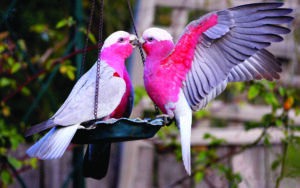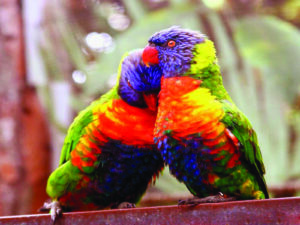By Dr. Beth Leermakers
How did Valentine’s Day — a religious celebration of the decapitation of a third-century Christian martyr — turn into a romantic holiday? Lovebirds get the credit — or the blame, depending on how you feel about the Hallmark holiday.

Photos courtesy of LovebirdsWallpaper
The love connection dates back to Geoffrey Chaucer, the 14th century English poet who was employed by King Richard II. To commemorate the one-year anniversary of the king’s engagement to Anne of Bohemia, Chaucer wrote a poem called “Parliament of Fowls,” comparing the mating rituals of birds to those of people. One line says “For this was on St. Valentine’s Day when every bird cometh there to choose his mate.”
Apparently in Chaucer’s day, birds paired off in February to produce eggs. European nobility began sending love letters during bird-mating season. In February 1415, the French Duke of Orléans, who spent years as a prisoner in the Tower of London, wrote to his wife, whom he called his “very gentle Valentine,” telling her he was lovesick. By the Elizabethan era (1558-1603), birds were commonly associated with love and Valentine’s Day.
Lovebirds, who form strong bonds with their monogamous mates, are appropriate symbols of love. Lovebirds are small parrots (5-7 inches long from beak to the end of their tail feathers) that belong to the genus Agapornis (from the Greek words “agape,” meaning love or affection, and “ornis,” meaning bird). There are nine species of lovebirds that are native to Africa. You might see a lovebird in your yard if you live in the American Southwest or San Francisco, where there are flocks of birds who escaped from an aviary.

Sharing is caring. The courtship ritual starts with the male lovebird wooing the female by regurgitating (bringing swallowed food up into his mouth) and feeding her. He bobs his head up and down to bring food back from his crop (the pouch on the front of his neck, where food is stored) into his mouth. Later in their relationship, the male feeds his mate when she lays eggs and when their chicks are born. Who says chivalry is dead?
Public displays of affection. These affectionate birds often sit together and caress or preen their mate (i.e., clean and arrange each other’s feathers). After a long separation or stressful period, lovebird couples feed each other to re-establish their bond. One bird transfers food to the mouth of its mate, like human couples feeding each other chocolate-dipped strawberries .
Until death us do part. Lovebirds mate for life and pine for each other. If a lovebird’s mate dies or gets separated from the flock, the remaining bird displays erratic behavior that is similar to depression. However, after their mate dies, lovebirds eventually move on and find a new partner.
Lovebirds don’t play well with others. These little parrots are territorial and don’t get along well with birds of other species. Within their own flock, lovebirds can be jealous or hormonal during mating season. Lovebirds kept in captivity sometimes attack other lovebirds and other bird species.
One Lovebird May be
Better than Two
Lovebirds are one of the most popular parrot species kept as pets. Although these birds are extremely social and thrive on interaction, it is not always best to keep lovebirds in pairs. It is a myth that a solitary lovebird will die of depression.
Why keep only one bird? The birds breed readily in captivity, and most people are not equipped to care for a family of parrots. Furthermore, birds kept in pairs tend to bond with each other and ignore their people. If you want an affectionate bird that lets you handle her, you’re better off keeping a single bird and spending as much time as possible playing with her so her social needs are met.
As you’re celebrating Valentine’s Day with your sweetheart, be glad you’re sharing surf and turf and chocolates and champagne instead of already-been-chewed leftovers.
Happy Valentine’s Day!
